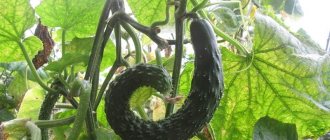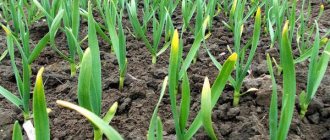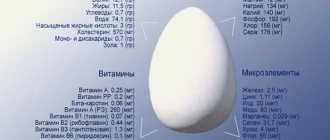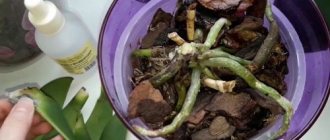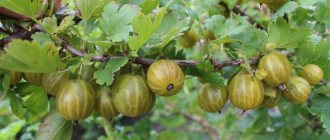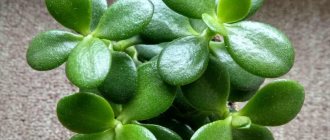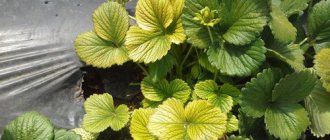Deformed cucumbers are not such a rare occurrence. Even experienced summer residents run the risk of encountering this problem. Why do cucumbers grow crooked? How can this be avoided? We will give you recommendations that will allow you to grow even cucumbers.
The illustration for the article is taken from open sources 457
Reason 1. Micronutrient deficiency
Curvature of cucumbers is often associated with a lack of microelements. As a rule, this crop lacks potassium or nitrogen. If you did not apply complex fertilizers to the soil during the season, it is possible that cucumbers also need other microelements.
Related article:
Pinching cucumbers: why and how to do it
Potassium deficiency
Plants often need potassium-based fertilizing, since its reserves in the soil are greatly depleted by the end of July. At night, the temperature changes, which negatively affects the absorption of this element. The fact that cucumbers need potassium replenishment is evidenced by their yellow tint and change in shape. At the same time, their leaves turn pale and curl downward.
In some cases, necrotic spots may appear. This problem can be solved by treating with a solution based on potassium salt. To prepare it, you need to dilute 25-30 g of the product in a bucket of water. You can start watering only after 4 days. After this, sprinkle with potassium sulfate. For 1 sq. m of ridge will require 40-60 g of the substance. You can also apply an ash-based solution under the bush (0.5 liters of ash per 1 bucket of water).
Related article:
Secrets of late sowing of cucumbers
The illustration for the article is taken from open sources
Nitrogen deficiency
If cucumbers do not have enough nitrogen, they become light green and narrow on the flower side, and, on the contrary, expand in the stalk area. In other words, their shape vaguely resembles a carrot. In addition, they noticeably lag behind in growth, harden, and their leaves become small and lose their brightness.
If you notice that cucumbers are growing deformed, spray them with a urea solution (5 g per 1 liter of water). After 5 days, fertilize the soil with ammonium nitrate. To prepare the fertilizer, you need to dilute 3 tbsp in 10 liters of water. l. of this substance. You need to be careful when applying these fertilizers, as excess nitrogen can lead to shedding of the ovaries.
Organic fertilizers are considered an excellent alternative. The mullein solution has proven itself to be the best. It is unacceptable to use it in its pure form. The product should be diluted in a ratio of 1:10. The source of nitrogen is a herbal infusion. Before pouring it over the cucumbers, you need to dilute it with water (1:10).
Related article:
I plant cucumbers using the method of a Belarusian aunt
The illustration for the article is taken from open sources
Complex micronutrient deficiency
If several elements are missing at the same time, cucumbers take on an intricate shape. May resemble giant insects or a dumbbell. If you want the fruits to be even, treat the bushes with nitroammophos (25 g per 1 liter of water). You can begin subsequent processing only after 7 days.
The illustration for the article is taken from open sources
Other reasons causing deformation of greens
Poor pollination
Poor or incomplete pollination of bee-pollinated varieties is the reason for the presence of pear-shaped or pomegranate-shaped greens (as with a lack of potassium).
Somewhat less frequently, insufficient pollination in bee-pollinated varieties can cause deformations similar to nitrogen deficiency , i.e. The cucumbers will be pointed (wedge-shaped) .
Why can cucumbers be poorly pollinated?
- The main factors that reduce the age and activity of bees (pollinators) are cloudy weather and rain.
- Too low or high temperatures (extreme weather conditions) also negatively affect pollen viability.
Pollination of parthenocarpic cucumbers
Parthenocarpic (not requiring pollination) and bee-pollinated cannot be grown in one greenhouse (or one bed in open ground) . Otherwise, with such a joint planting, the greens will turn out to be crooked, ugly and, as a rule, pear-shaped (bottle-shaped) (as in the case of a lack of potassium).
The thing is that pollinating insects (bees, bumblebees) will also pollinate the flowers of parthenocarpic cucumbers , which do not need this and will only do harm, namely, due to pollination, the seeds will set unevenly throughout the fruit (the seed chambers will not form correctly), This is why the cucumbers will turn out “clumsy”.
Advice! Therefore, in summer greenhouses and hotbeds with constantly open ends and transoms through which bees fly freely, and even more so in open ground, it is better to plant ordinary bee-pollinated varieties, which produce even fruits when pollinated.
Or plant only parthenocarpic hybrids or bee-pollinated varieties .
Late harvest of fruits
In some cases, if you leave large overgrown fruits on the plant, this can cause deformation of young greens and they will become similar in shape to “barrels” (as with insufficient and infrequent watering).
Dense plantings and lack of light
Another common cause of curvature of greens.
The solution is simple: initially plant seedlings or plant seeds at a sufficient distance, and subsequently pinch and pinch cucumber vines .
Reason 2. Improper watering
Cucumbers need to be provided with water at a comfortable temperature. If it is less than 25-28°C, this is fraught with a change in shape. Untimely watering also affects the fruits; they harden and curl. As soon as the ovaries appear, the bushes need to be watered every 2-3 days. After August 15, if the weather is good, you can carry out the procedure once every 7-14 days.
If for some reason you are unable to moisten the soil regularly, but the summer is quite hot, use a drip irrigation system. Such a device has many advantages. It allows you to use water sparingly and reduces the risk of developing fungal diseases.
Related article:
How to increase the yield of cucumbers: 10 useful tips
The illustration for the article is taken from open sources
Violations of the rules for watering cucumbers
Cucumbers need to be watered correctly. Moreover, due to violations of the watering regime, cucumbers can not only become crooked, but also begin to taste bitter .
Advice! The site has material on when and how to properly water cucumbers in a greenhouse and open ground .
Insufficient watering
If your cucumbers look like hooks (have acquired a hook-like shape)
, then most likely it’s a matter of insufficient watering.
By the way! Due to lack of moisture, cucumbers can also become bitter .
Also, due to drying out of the soil and infrequent watering, cucumbers can become barrel-shaped .
How often and how much to water cucumbers:
- The norm for watering cucumbers is 2-5 liters per plant, depending on its size (at the beginning of the growing season - less, during the period of growth and fruiting - more) and soil type.
- Watering frequency: every day in dry and hot weather, every other day or two in other cases.
Watering with cold water
Another reason why cucumbers can become crooked, or rather narrow in the middle , is watering with cold water.
Also, constriction on the fruits can form due to irregular watering (alternating normal and insufficient soil moisture).
Water the cucumbers only with warm water (not lower than +16, optimally +20-25 degrees):
- It is strictly prohibited to water cucumbers with ice water from a well or well.
- When they say “warm”, this does not mean at all that the water needs to be specially heated. It is enough if your container of water is placed in the sun or in a greenhouse.
Reason 3. Temperature changes
If cucumbers are grown outside a greenhouse in late August, you may find that they take on an hourglass shape. In this case, the reason lies in sudden temperature changes. It may still be hot during the day, but the nights are already cold. To prevent the fruits from changing their shape, provide them with protective cover at night.
The illustration for the article is taken from open sources
Why are cucumbers bitter?
The cause of the change in taste is an organic compound - cucurbitacin.
This substance is present in small quantities in fruits, without at all spoiling the taste characteristics. Under “stressful” circumstances for plants, the percentage of cucurbitacin increases significantly, so the bitterness becomes noticeable. First of all, the substance is synthesized in the leaves, after which it enters the root system and is distributed throughout the plant, including the fruits. The highest concentration is observed in the peel (especially near the stalk). To get rid of bitterness, in most cases it is enough to peel the fruit.
Cucurbitacin is present not only in cucumbers, but also in other edible and inedible members of the Cucurbitaceae family, such as pumpkin, melon, and bryonia.
In the 18th century, due to the unpleasant bitterness, doctors in England considered cucumbers poisonous and did not recommend eating them. This opinion is wrong. The specific substance does not pose a danger to humans and even brings benefits - it has antitumor, anthelmintic, antimicrobial, and anti-inflammatory properties.
Reason 4. Under-pollination of cucumbers
If vegetables are not pollinated as expected, this is indicated by their hooked shape and uneven coloring. The fruits darken closer to the stalk and lighten in the flower area. To prevent this phenomenon, you can resort to artificial pollination.
If the moment when this needs to be done is missed, treat the bushes with a solution of boric acid (3 g per 1 liter of water). Remember that the key to a high-quality harvest is sowing seeds of self-pollinating varieties and hybrids.
Related article:
The best varieties of bunched cucumbers for open ground and greenhouses
The illustration for the article is taken from open sources
Lack of light
If plants are planted too closely together, they will not receive the required amount of sunlight, which in turn can cause unexpected deformation of the fruit. The same thing happens if the summer was cloudy. Therefore, it is worth planting vegetables at a certain distance from each other and ensuring that the process of photosynthesis occurs at the desired level.
It is also worth considering the characteristics of the selected variety. Some of them are simply not suitable for specific regions or require special growing and care conditions. In addition, there are varieties for which such curvatures are a common feature. For example, Chinese cucumbers quite often grow with a slight bend, and this is considered absolutely normal.
The recommendations given in the article will help you get the best quality harvest. The main thing is to approach the issue responsibly and provide the plants with the necessary care.
Reason 5. Incorrect fit
Not so rarely, inexperienced summer residents often make one mistake - they plant different varieties and hybrids of cucumbers close to each other. In this case, obtaining fruits of intricate shapes is a natural phenomenon. Never plant bee-pollinated or parthenocarpic varieties that do not require pollination next to each other. If you ignore this recommendation, partial cross-pollination and crossing of species will occur. As a result, you will end up with hooked specimens that are not entirely appropriate to use for preservation, since they will not be easy to remove from the jar. Before sowing the seeds, read the instructions.
Do not plant regular and parthenocarpic varieties and hybrids next to each other. Follow the rules of crop rotation. Do not sow cucumbers in the same place as last year. As for predecessors, you can sow cucumbers in a bed that was previously occupied by white cabbage, cauliflower, tomatoes, potatoes, peas, and beets. It is not recommended to plant cucumbers in a place that previously belonged to pumpkin plants. This is only allowed after 4 years.
Related article:
How to get cucumbers to bear fruit before frost
The illustration for the article is taken from open sources
Why cucumbers grow crooked: reasons
Conventionally, the main reasons why cucumbers become distorted can be divided into the following 2 groups:
- lack of nutrition (macroelements - nitrogen or potassium);
- improper watering (insufficient watering or watering with cold water).
Cucumbers can also grow crooked due to:
- insufficient pollination of bee-pollinated varieties;
- pollination of parthenocarpic hybrids by pollinating insects (bees);
- untimely harvesting of fruits;
- adverse weather conditions.
By the way! Hookiness is especially characteristic of long hybrids and varieties of cucumbers, in particular Chinese . This is a kind of varietal feature.
Reason 6. Late harvest
Cucumbers should be collected every 2-3 days. If these intervals are extended, most of the fruit will become overripe and the plant will not be able to distribute nutrients. As a result, young cucumbers will surprise with their intricate shapes.
The illustration for the article is taken from open sources
How to determine what cucumbers are missing
If abnormal fruits are formed, you should not increase watering, as this will not solve the problem and may lead to rotting of the roots. If the cucumbers are pear-shaped or crooked, most often the bush lacks microelements. You need to carefully examine the plants, paying attention to the following problems:
- reducing sheet size;
- leaf lightening;
- reduction in the number of ovaries;
- curvature of the fetus at an early age.
At any of these signals, you need to introduce nitrogen fertilizers - a urea solution at the root or by spraying the entire bush.
Phosphorus deficiency is manifested by accelerated growth of empty side shoots, and the leaves become lighter and may show signs of necrosis. The plant has a sickly and lethargic appearance.
Potassium deficiency can be determined by the following signs:
- bitterness of fruits;
- darkening of leaves;
- the appearance of a light border on the leaves;
- absence or minimal number of ovaries.
With a deficiency or excess of magnesium, light and dark spots appear on the leaves. In some cases, the foliage even curls. Problems with manganese cause protruding and darkening of the veins on the leaves. Calcium deficiency is identified by an unhealthy yellow border on the leaves. The same symptom is characteristic of the lack of a sufficient amount of boron.
Did you know? With the help of a cucumber, door handles and other shiny surfaces will simply shine: just wipe them with a small slice of the vegetable.
Poor landing site and other violations
Why don't cucumbers grow in a greenhouse?
Planting after pumpkin, strawberries, tomatoes and eggplants practically guarantees hook-shaped fruits at the end, since these crops take nitrogen from the soil.
Green manure, in particular oats, will help enrich the soil with the necessary elements.
It is also very important to carefully study the information about the varieties being planted, what temperature they require, and how much sun they need. Having planted a light-loving variety in a region where it rains 300 days a year, you may not be surprised at the appearance of ugly cucumbers.
Incorrect composition of fertilizers
A common cause of distorted fruits is phosphorus deficiency or the predominance of nitrogen over phosphorus and potassium in the soil and plants as a result of unbalanced nutrition. If there is no predominance of nitrogen, then you can feed the plants with a Solution solution. In any case, you can feed with a solution of potassium monophosphate or superphosphate. The first fertilizer is more expensive, but it dissolves more easily in water.
Moreover, some people think that the problem can be corrected with nitrogen-based fertilizers, and therefore they begin to actively apply only these types of fertilizers. The result of such actions is deformation of the fruit. An increased amount of nitrogen in the soil against the background of a lack of phosphorus and potassium causes the ovary to fall off.
Advice from experienced summer residents
Gardeners recommend that you initially pay close attention to the planting conditions, so that you don’t have to take measures to correct mistakes later.
In addition to proper care, it is important:
- observe crop rotation - do not plant cucumbers in the same area for more than 2 years in a row, as well as in places where zucchini, pumpkin, and dill are grown;
- choose a suitable variety - self-pollinating should grow in a greenhouse, insect-pollinated in open areas;
- leave enough space when planting - 15-20 cm between rows of bushes.
The water used for irrigation is first left in the sun to warm it up, or diluted with boiling water. For 1 m², 5-8 liters of water are used for young bushes, and for fruiting - 120 liters. Foliar feeding is best done in rainy weather.
Reference. If you cannot follow the rules of crop rotation, you can restore the soil for the next planting with the help of green manure plants. After the autumn harvest, mustard, oats or phacelia are planted on the site. By the end of autumn, the crops will have grown, they can be dug up, and cucumbers can be planted in the spring.
How to deal with the curved shape of cucumbers
irregularly shaped cucumber
In most cases, the curved shape is observed when there is a thickening of the planting and a lack of light. The fruits also become crooked at low temperatures at night (below +12 degrees), as well as when there is damage by thrips and aphids.
Treatment in this case comes down to planting seedlings in accordance with the required nutritional area. If it is open soil, there should be no more than five seedlings per square meter, but if greenhouse cultivation is planned - two to three seedlings.
We must also remember about the formation of cucumber vines, timely pinching of shoots on the side, and planting a vegetable garden in well-lit areas, away from buildings and trees.
